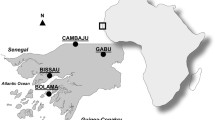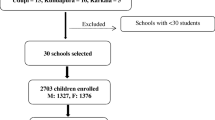Abstract
Thirty primary schools were selected in district Kangra utilizing the population proportionate to size cluster sampling methodology in the year 2004. A total of 6939 children were included in the study. The clinical examination of the thyroid of each child was conducted. On the spot casual urine sample and salt samples were collected from a ‘sub set of’ children included in the study. The Total goiter rate (TGR) was found to be 19.8%. The median Urinary iodine excretion level was 200 μg/l and only 64% of the salt samples had the stipulated level of iodine. The findings of the present study revealed that current iodine status of population is adequate, however, TGR showed mild iodine deficiency (chronic), and there is a need of continued monitoring the quality of iodised salt provided to the beneficiaries under the Universal salt iodisation programme in order to achieve the goal of elimination of lodine deficiency disorders from district Kangra.
Similar content being viewed by others
References
Ramalingaswami V, Subramanian TA, Deo MG. The aetiology of Himalayan endemic goiter. 1961. Natl Med J India 2001; 14: 180–184.
Agrawal DK, Agarwal KN. Current status of endemic goiter in some areas of sub-Himalayan belt. Indian Pediatr 1983; 20: 471–477.
Karmarkar MG, Ramalingaswami V. Pathophysiology of Himalayan endemic goiter. Acta Endocrinol 1973; 179: 38–39.
Sooch SS, Deo MG, Karmarkar MG, Kochupillai N, Ramachandran K, Ramalingaswami V. Prevention of endemic goiter with iodised salt. Bull WHO 1973; 49: 307–312.
Sooch SS, Deo MG, Karmarkar MG, Kochupillai N, Ramachandran K, Ramalingaswami V. The Kangra valley experiment: prevention of Himalayan endemic goiter with iodinated salt. Acta Endocrinol 1973; 179: 110.
Kapil U, Sohal KS, Sharma TD, Tandon M, Pathak P. Assessment of iodine deficiency disorders using the 30 cluster approach in District Kangra, Himachal Pradesh, India. J Tropical Pediatr 2000; 46: 264–266.
Indicators for assessing iodine deficiency disorders and their control through salt iodisation. WHO/UNICEF/IDD. World Health Organisation, Geneva; 1994.
NFHS (2000) India 1998-1999-National Family Health Survey-2 (NFHS-2)-Himachal Pradesh. Background characteristics of households, 2000: 24.
Blinkin NJ, Sullivan K, Staehling N, Nieburg P. Rapid nutrition surveys: how many clusters are enough? Disasters 1992; 16: 97–103.
Dunn JT, Crutchfield HE, Gutekunst R, Dunn D. Methods for measuring iodine in urine. A joint publication of WHO/UNICEF/ICCIDD; 1993. p. 18–23.
Kapil U, Dwivedi SN, Seshadri S, Swami SS, Beena, Mathur BP, Sharma TD, Khanna K, Raghuvanshi RN, Tandon M, Pathak P, Pradhan R. Validation of spot testing kit in the assessment of iodine content of salt: a multi-centric study. Indian Pediatr 2000;37:182–186.
Kapil U, Saxena N, Ramachandran S, Sharma TD, Nayar D. Status of iodine deficiency in selected blocks of Kangra district, Himachal Pradesh. Indian Pediatrics 1997; 34: 338–340.
Author information
Authors and Affiliations
Corresponding author
Rights and permissions
About this article
Cite this article
Kapil, U., Sharma, T.D. & Singh, P. Iodine status and goiter prevalence after 40 years of salt iodisation in the Kangra district, India. Indian J Pediatr 74, 135–137 (2007). https://doi.org/10.1007/s12098-007-0005-2
Published:
Issue Date:
DOI: https://doi.org/10.1007/s12098-007-0005-2




